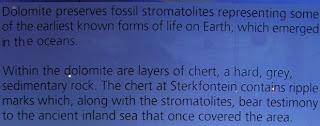
For the identification of insects and other fauna and flora of South Africa.
Sunday, January 30, 2011
Thursday, January 27, 2011
Sterkfontein Caves - Part 3
Part of the complex consists of six cathedral chambers, largest of which is the dripstone-decorated Hall of Elephants, 23 m (75 ft) high and 91 m (300 ft) long.
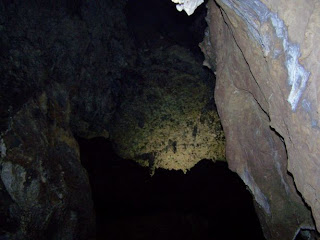 Other chambers include Fairy Chamber, Bridal Arch, Lumbago Alley and the Graveyard.
Other chambers include Fairy Chamber, Bridal Arch, Lumbago Alley and the Graveyard.
 Dr Robert Broom, of the Transvaal Museum in Pretoria, began excavations of the cave in 1936 and made several discoveries of bones and other fossils.
Dr Robert Broom, of the Transvaal Museum in Pretoria, began excavations of the cave in 1936 and made several discoveries of bones and other fossils.
 Other chambers include Fairy Chamber, Bridal Arch, Lumbago Alley and the Graveyard.
Other chambers include Fairy Chamber, Bridal Arch, Lumbago Alley and the Graveyard. Dr Robert Broom, of the Transvaal Museum in Pretoria, began excavations of the cave in 1936 and made several discoveries of bones and other fossils.
Dr Robert Broom, of the Transvaal Museum in Pretoria, began excavations of the cave in 1936 and made several discoveries of bones and other fossils.Monday, January 24, 2011
Sterkfontein Caves - Part 2
Discovered by an Italian prospector Guigimo Martinaglia, who was searching for gold and lime in 1896, this labyrinth of interconnected caverns was formed over millions of years by underground waters slowly dissolving the dolomitic rock.
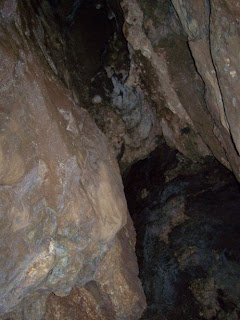


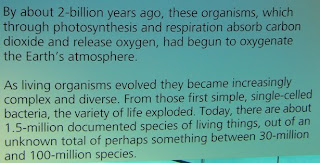 Now the water table has dropped and the spectacular eroded shapes of the dolomite can be seen as one walks through a vast chamber to an under ground lake which fills other extensive caves beneath its surface.
Now the water table has dropped and the spectacular eroded shapes of the dolomite can be seen as one walks through a vast chamber to an under ground lake which fills other extensive caves beneath its surface.
 Its tranquil, crystal-clear waters extend some distance into unexplored chambers.
Its tranquil, crystal-clear waters extend some distance into unexplored chambers.
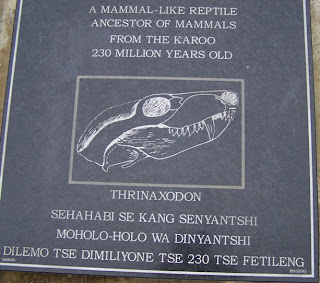
 Several interesting dripstone formations are to be seen; although, sadly, many of the cave's more spectacular stalactites and stalagmites were removed or damaged by early limestone-mining activities.
Several interesting dripstone formations are to be seen; although, sadly, many of the cave's more spectacular stalactites and stalagmites were removed or damaged by early limestone-mining activities.



 Now the water table has dropped and the spectacular eroded shapes of the dolomite can be seen as one walks through a vast chamber to an under ground lake which fills other extensive caves beneath its surface.
Now the water table has dropped and the spectacular eroded shapes of the dolomite can be seen as one walks through a vast chamber to an under ground lake which fills other extensive caves beneath its surface. Its tranquil, crystal-clear waters extend some distance into unexplored chambers.
Its tranquil, crystal-clear waters extend some distance into unexplored chambers.
 Several interesting dripstone formations are to be seen; although, sadly, many of the cave's more spectacular stalactites and stalagmites were removed or damaged by early limestone-mining activities.
Several interesting dripstone formations are to be seen; although, sadly, many of the cave's more spectacular stalactites and stalagmites were removed or damaged by early limestone-mining activities.Friday, January 21, 2011
Sterkfontein Caves - Part 1
The Sterkfontein Caves - about 50 (30 miles) km from Johannesburg - is the site of some of the most important discoveries concerning the evolution of man and has been declared a World Heritage Site.
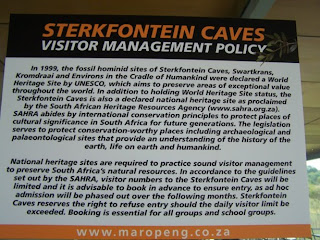

Friday, January 14, 2011
Dahlias - Part 1
Tuesday, January 11, 2011
Caveman days - The fire plant
This plant dates back to caveman days and was frequently still used up to about 100 years ago. Now, with the advent of electricity, the usefulness has died out but if you every find yourself stranded in Africa, remember it.
We call it "the Baboons Tail" and even after a veld (bush) fire, new leaves still pop out.
It grows to about 3-4 feet in height.
 There is not a place in South Africa where I have not seen it growing.
There is not a place in South Africa where I have not seen it growing.
 If you seperate the very fine parts of the stem.....
If you seperate the very fine parts of the stem.....
 you can see how fibrous it is inside.
you can see how fibrous it is inside.
 What cave dwellers did was take one of these "tails" and soak it in animal fat for 3 or 4 days. The fat would draw into the fibre and when set alight, would burn for about 4 hours depending on the lenght of it.So, when we go back to living in caves, remember to have some of these useful plants around.
What cave dwellers did was take one of these "tails" and soak it in animal fat for 3 or 4 days. The fat would draw into the fibre and when set alight, would burn for about 4 hours depending on the lenght of it.So, when we go back to living in caves, remember to have some of these useful plants around.
We call it "the Baboons Tail" and even after a veld (bush) fire, new leaves still pop out.
It grows to about 3-4 feet in height.
 There is not a place in South Africa where I have not seen it growing.
There is not a place in South Africa where I have not seen it growing. If you seperate the very fine parts of the stem.....
If you seperate the very fine parts of the stem..... you can see how fibrous it is inside.
you can see how fibrous it is inside. What cave dwellers did was take one of these "tails" and soak it in animal fat for 3 or 4 days. The fat would draw into the fibre and when set alight, would burn for about 4 hours depending on the lenght of it.So, when we go back to living in caves, remember to have some of these useful plants around.
What cave dwellers did was take one of these "tails" and soak it in animal fat for 3 or 4 days. The fat would draw into the fibre and when set alight, would burn for about 4 hours depending on the lenght of it.So, when we go back to living in caves, remember to have some of these useful plants around.
Subscribe to:
Posts (Atom)











